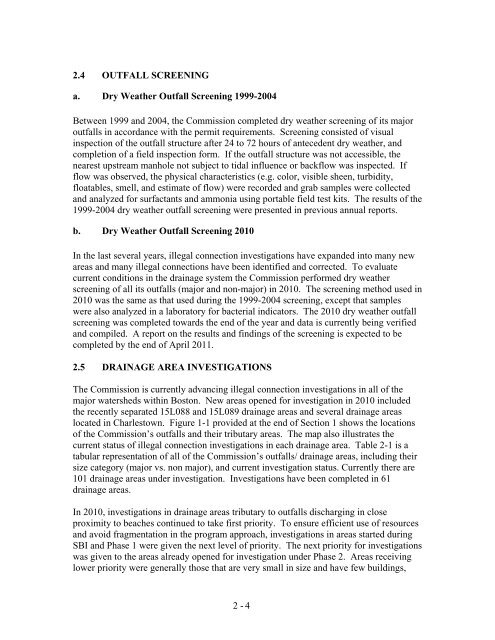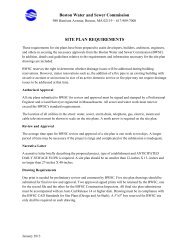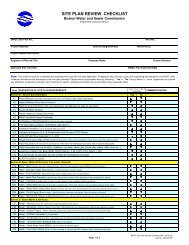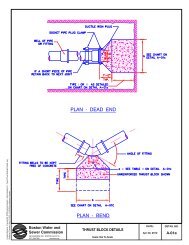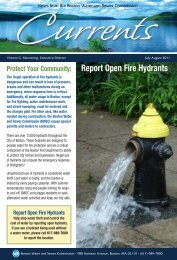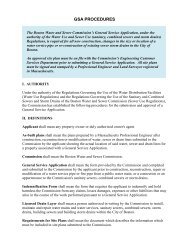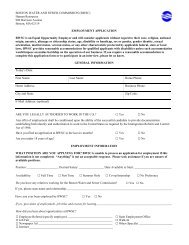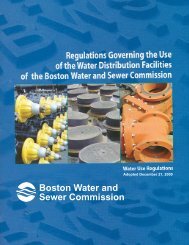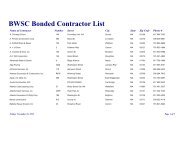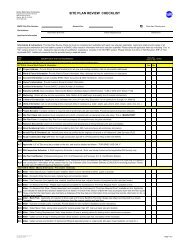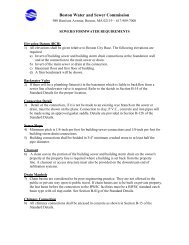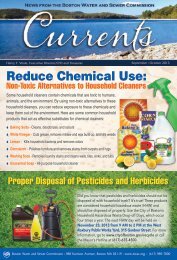2010 Stormwater Management Report (PDF) - US Environmental ...
2010 Stormwater Management Report (PDF) - US Environmental ...
2010 Stormwater Management Report (PDF) - US Environmental ...
You also want an ePaper? Increase the reach of your titles
YUMPU automatically turns print PDFs into web optimized ePapers that Google loves.
2.4 OUTFALL SCREENING<br />
a. Dry Weather Outfall Screening 1999-2004<br />
Between 1999 and 2004, the Commission completed dry weather screening of its major<br />
outfalls in accordance with the permit requirements. Screening consisted of visual<br />
inspection of the outfall structure after 24 to 72 hours of antecedent dry weather, and<br />
completion of a field inspection form. If the outfall structure was not accessible, the<br />
nearest upstream manhole not subject to tidal influence or backflow was inspected. If<br />
flow was observed, the physical characteristics (e.g. color, visible sheen, turbidity,<br />
floatables, smell, and estimate of flow) were recorded and grab samples were collected<br />
and analyzed for surfactants and ammonia using portable field test kits. The results of the<br />
1999-2004 dry weather outfall screening were presented in previous annual reports.<br />
b. Dry Weather Outfall Screening <strong>2010</strong><br />
In the last several years, illegal connection investigations have expanded into many new<br />
areas and many illegal connections have been identified and corrected. To evaluate<br />
current conditions in the drainage system the Commission performed dry weather<br />
screening of all its outfalls (major and non-major) in <strong>2010</strong>. The screening method used in<br />
<strong>2010</strong> was the same as that used during the 1999-2004 screening, except that samples<br />
were also analyzed in a laboratory for bacterial indicators. The <strong>2010</strong> dry weather outfall<br />
screening was completed towards the end of the year and data is currently being verified<br />
and compiled. A report on the results and findings of the screening is expected to be<br />
completed by the end of April 2011.<br />
2.5 DRAINAGE AREA INVESTIGATIONS<br />
The Commission is currently advancing illegal connection investigations in all of the<br />
major watersheds within Boston. New areas opened for investigation in <strong>2010</strong> included<br />
the recently separated 15L088 and 15L089 drainage areas and several drainage areas<br />
located in Charlestown. Figure 1-1 provided at the end of Section 1 shows the locations<br />
of the Commission’s outfalls and their tributary areas. The map also illustrates the<br />
current status of illegal connection investigations in each drainage area. Table 2-1 is a<br />
tabular representation of all of the Commission’s outfalls/ drainage areas, including their<br />
size category (major vs. non major), and current investigation status. Currently there are<br />
101 drainage areas under investigation. Investigations have been completed in 61<br />
drainage areas.<br />
In <strong>2010</strong>, investigations in drainage areas tributary to outfalls discharging in close<br />
proximity to beaches continued to take first priority. To ensure efficient use of resources<br />
and avoid fragmentation in the program approach, investigations in areas started during<br />
SBI and Phase 1 were given the next level of priority. The next priority for investigations<br />
was given to the areas already opened for investigation under Phase 2. Areas receiving<br />
lower priority were generally those that are very small in size and have few buildings,<br />
2 - 4


